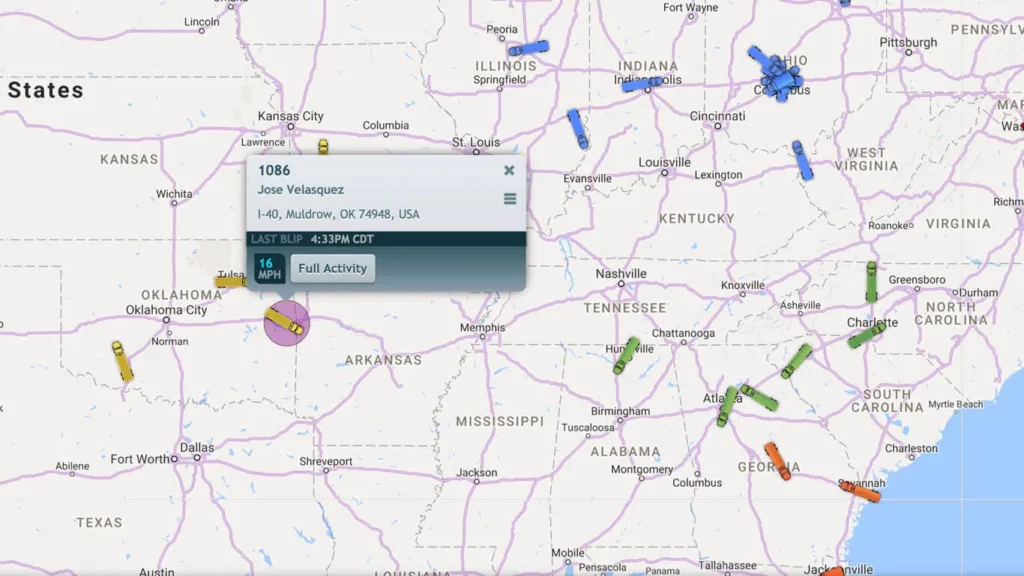Telematics is the technology used to monitor and transfer information among vehicles and vehicle-related equipment. Especially in the fleet industry, proper telematics is essential for collecting and tracking accurate data, such as driver behavior, vehicle activity and location, and more. Leveraging telematic tools like GPS trackers and onboard diagnostics helps streamline procedures and improves vehicle and driver performance.
A telematics system can use a range of technology, but typically has three main elements:
Tracking devices for fleet vehicles use certain types of software and technology to keep track of and store a vehicle’s most useful data. This can include elements like:
Two of the most important elements for telematics are GPS and OBD technology. GPS technology monitors a vehicle’s location and provides important insights about things like fuel efficiency and route optimization. OBD is an automotive, computer-based system that regulates and reports on a vehicle’s performance.
Especially between these two telecommunication tools, fleet managers can measure automotive metrics like idling time, driver behavior, vehicle activity, and the general health of the vehicle.

Once captured, the installed tracking device transmits the data through a cellular network, making it accessible from any device. Cellular networks make instant and easily accessible monitoring possible.
Then, there’s actually putting the data to use. Fleets managers need advanced, interactive fleet management software to track, document, and implement key performance information, especially for real-time activity and fleet reports.
Fleets are relying on telematics to the point that vehicles without such technology are becoming outdated and ineffective. The advantages speak for themselves.
A variety of fleet industries are taking advantage of telematics for its convenience and usefulness. From weather and road conditions to continual improvement in driver behavior, telematics is quickly becoming a fleet staple. Below are just a few of the most relevant industries.
Here are some specific examples of how real-time fleet management, GPS tracking, and telematics solutions are being used in different industries:
These solutions can help businesses of all sizes to improve efficiency, reduce costs, and improve safety.

Between increasingly mobile strategies and instantaneous data, the current state of telematics is only the beginning. The above industries are using telematics solutions because the competition demands it. As telematics advances, so will the rest of the fleet world. Businesses are creating more productive, more reliable, and more efficient services by embracing telematics innovations. Not only is it uniquely helpful in creating stronger workflows and better drivers, but as telematics becomes the new normal, businesses will fall behind without such technology. There are already advances being made, like video telematics, that are influencing telematics solutions in big ways.
Video telematics is changing the way fleets are being monitored. In-cab notifications and real-time monitoring make identifying and adjusting unsafe behavior more accurate and more honest. Typically, multiple cameras are installed, both inside and outside of the vehicle, so managers have an all-inclusive view of driver habits, safety, and vehicle use.
A big step up from a dashcam, video telematics capture the entire story. Plus, by being connected to a reliable monitoring system, immediate remote video footage is easily accessible. Faster responses from management and total accountability from drivers create a more open and effective coaching environment.
The exciting and groundbreaking strides that telematics is making is changing fleet and commercial management, and keeping up with advances can be challenging. Forward Thinking Systems makes staying up-to-date simple with cutting-edge technology and constant evaluation.
FleetCam, our all-in-one camera system, is a driving force behind modern camera monitoring, and our fleet management software is designed for integrative and convenient driver monitoring. With our extensive fleet management software, you also get real-time alerts that keep your fleet running with corrective reporting and quick turnaround times during unexpected roadblocks.
This is just the tip of the iceberg. Get a free demo to get started and begin experiencing Forward Thinking fleet solutions.
Recent Posts
Categories
Stay in Touch
Ready to make fleet management more manageable?